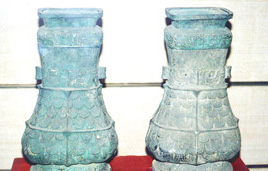| Legole.Com Discover china. Explore the beauty and wonder of the land, people, and culture of China. |
 |
|
|
 |
| |
Western Zhou (11th century BC - 711 BC)
Eastern Zhou
---- Spring and Autumn Period (770 BC - 476 BC)
---- Warring States Period (476 BC - 221 BC)
|
 The Golden Age of Wuding did not continue for very long after his death. During the following reigns, especially while Diyi and Dixin were in power, internal social conflict became more serious and neighboring states began to rebel. The last Shang Dynasty (The 16th - the 11th century BC) monarch, Dixin, normally known as King Zhou, was a despot just like King Jie of the Xia Dynasty (The 21st to the 17th century BC). Regardless of the instability of the state, Dixin ordered the construction of splendid palaces and gardens. He also used a large numbers of armies to attack the Eastern Yi tribe. As he devised and used cruel torture to repress those who disobeyed him, social unrest soon became intense. The Golden Age of Wuding did not continue for very long after his death. During the following reigns, especially while Diyi and Dixin were in power, internal social conflict became more serious and neighboring states began to rebel. The last Shang Dynasty (The 16th - the 11th century BC) monarch, Dixin, normally known as King Zhou, was a despot just like King Jie of the Xia Dynasty (The 21st to the 17th century BC). Regardless of the instability of the state, Dixin ordered the construction of splendid palaces and gardens. He also used a large numbers of armies to attack the Eastern Yi tribe. As he devised and used cruel torture to repress those who disobeyed him, social unrest soon became intense.
In the 11th century BC, a frontier state called Zhou gained prominence. Under the rule of King Wen, the kingdom of Zhou soon became powerful. When King Wen died, his son Jifa, known as King Wu succeeded him. In 1122 BC, assisted by Jiangshang and Zhoudan, King Wu launched a punitive attack against King Zhou of the Shang. Having suffered much during the reign of King Zhou, the Shang army turned coat and led the Zhou army to the Shang capital. King Zhou committed suicide and the Shang Dynasty collapsed.
The Shang was followed by a new dynasty named Zhou, also spelled Chou. The Zhou Dynasty is traditionally divided into two periods: the Western Zhou (11th century BC to 711 BC) with Haojing as its capital and the Eastern Zhou (770 BC - 221 BC), when the capital was moved east to present Luoyang.
Zhou reigned over 800 years and was the longest-ruling dynasty in Chinese history. It was especially noted for it brilliant achievements in culture.
|
|
|
 |
|
